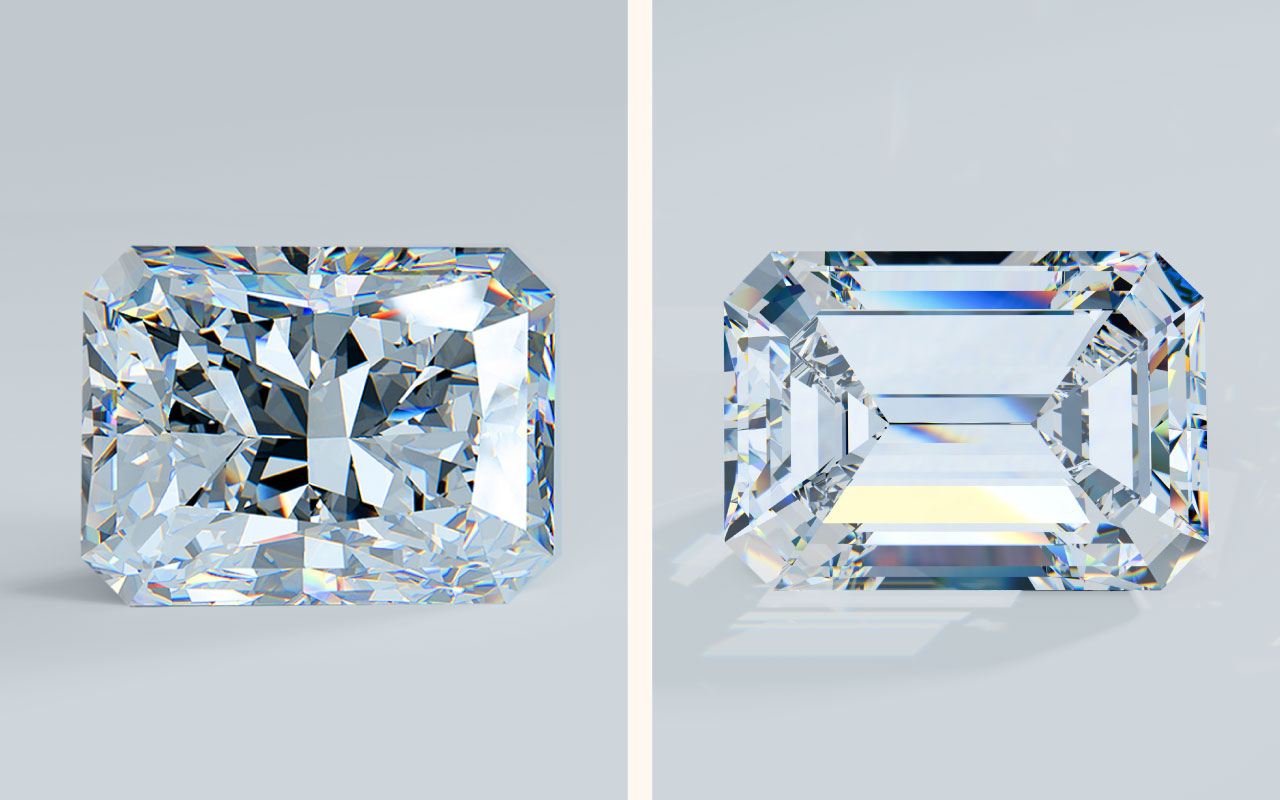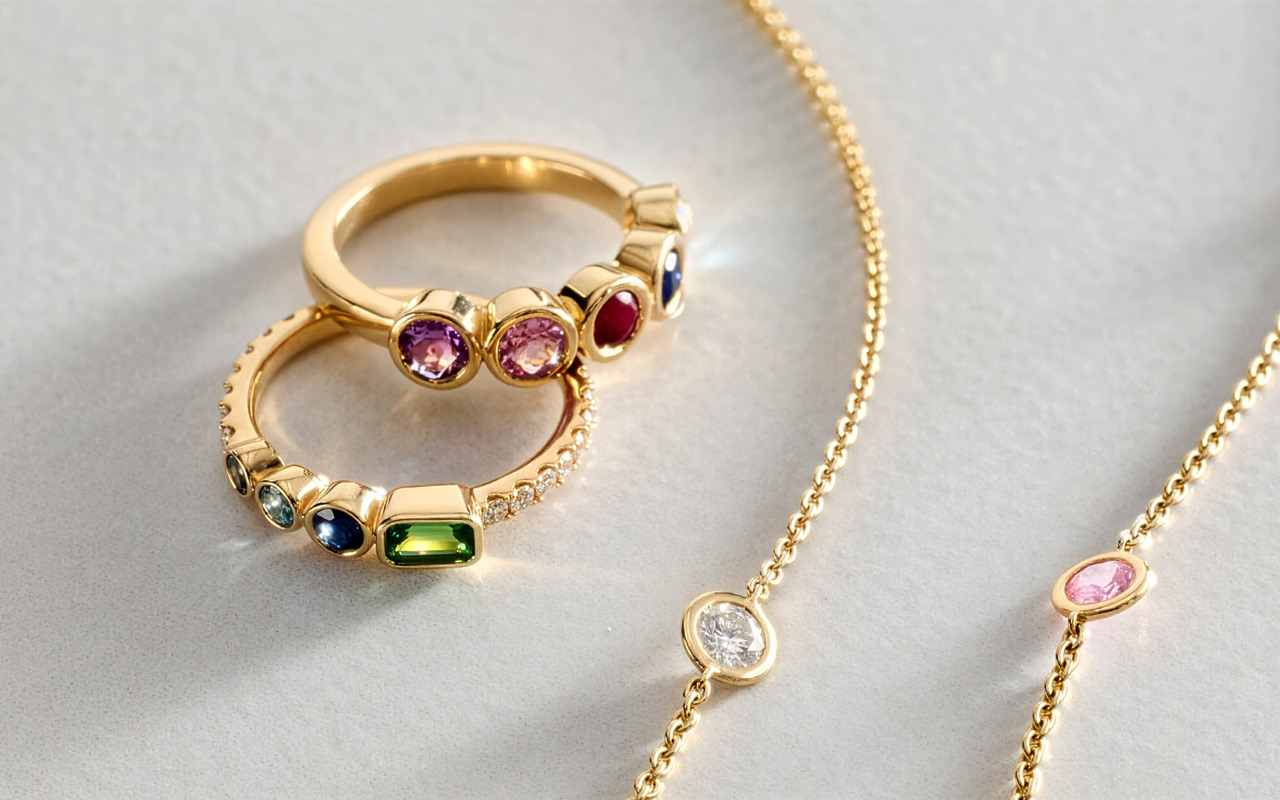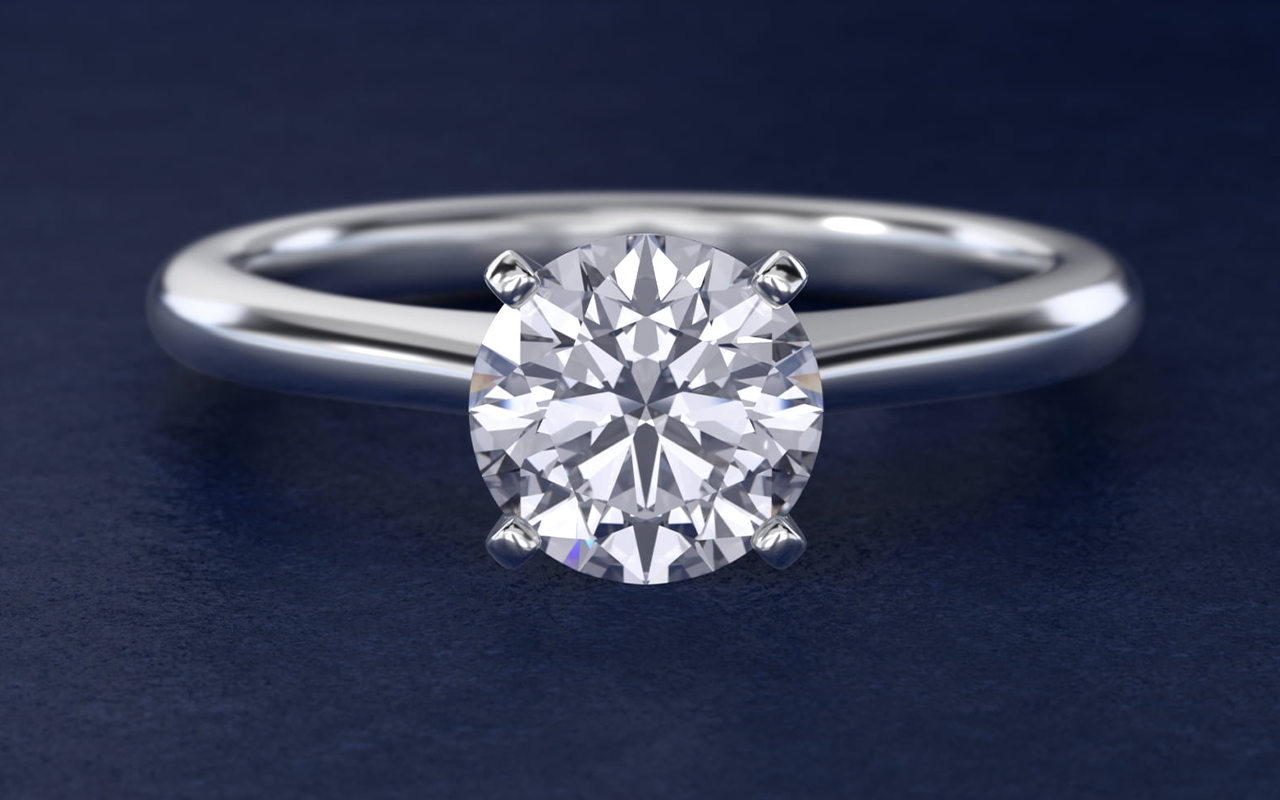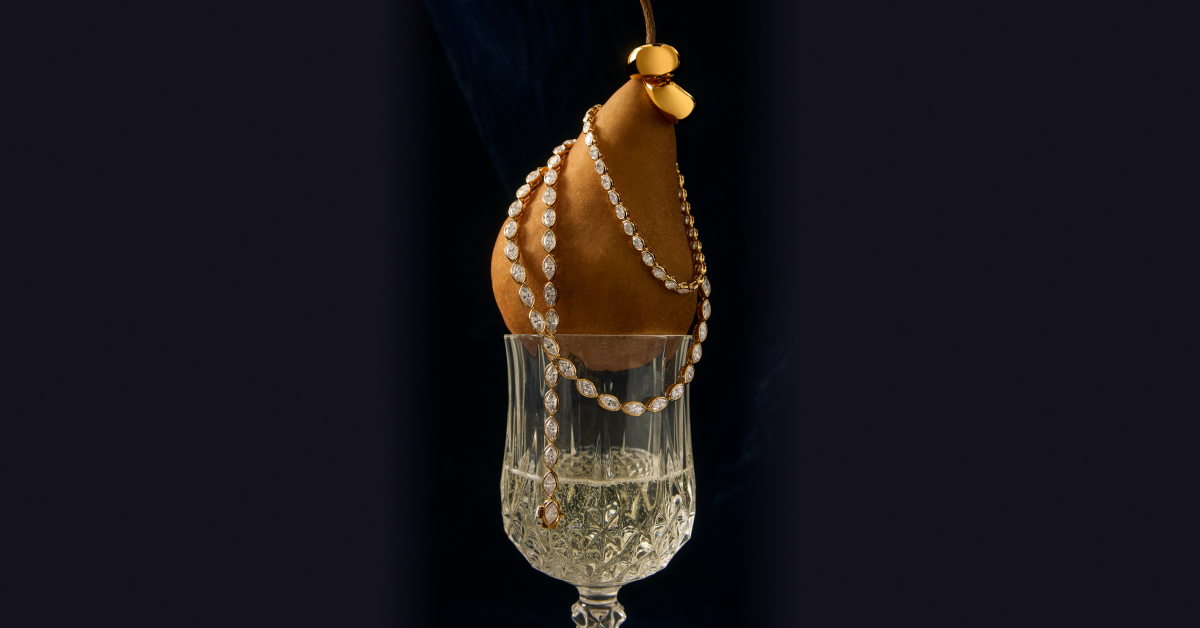Diamonds come in many shapes, each with its own personality and appeal. When comparing radiant vs. emerald cut diamonds, the difference often comes down to how each rectangular shape plays with light.
Radiant cuts are known for their brilliant facet pattern that delivers high-impact sparkle, while emerald cuts have long, stepped facets that create a smooth, mirror-like glow. Knowing these differences makes it easier to pick the diamond that’s right for you or your partner.
In this guide, we’ll explore how these two cuts differ in shape, brilliance and style, plus tips for choosing the one that best fits your taste and budget.
Key Differences Between Radiant and Emerald Cuts
When deciding between emerald vs. radiant cut diamonds, focus on how each rectangle cut diamond interacts with light. Radiant cuts deliver bold sparkle, while emerald cuts showcase sleek, mirrored planes.
Use the chart below to see how these cuts differ based on the 4Cs of diamonds (cut, color, clarity, carat) and more.
Category
Emerald cut style suggestion
Ring types
Settings
Metals
If you’re looking for a bold, modern ring, you might choose a radiant cut. However, if you prefer a classic ring with defined lines, an emerald cut may be the right fit.
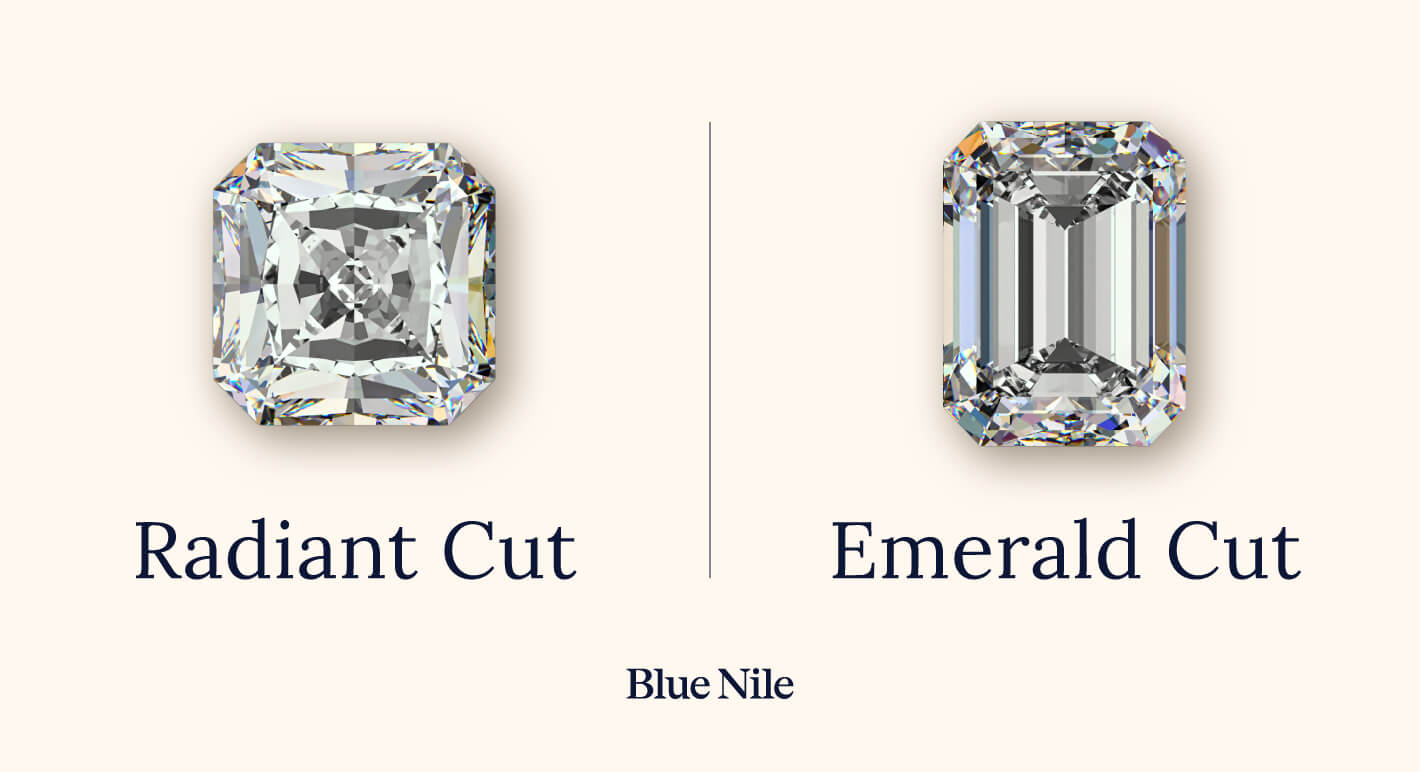
Radiant Cut Diamonds
Designed with a mix of step and brilliant facets, radiant cut diamonds deliver incredible fire and brilliance while maintaining a rectangular shape with slightly cropped corners. This creates a softer outline than the straight-edged emerald cut.
The cost of a radiant cut depends on factors like size, color, clarity and the precision of its cut. In general, diamonds with excellent symmetry and proportions often come with higher prices. Because radiants hide inclusions well, you may find better value than other brilliant cuts.
Here’s a quick breakdown of the characteristics of radiant cut diamonds:
- Facets: With 70 facets, the radiant combines the precision of step cuts and the dazzle of brilliant cuts. This unique structure gives the stone its signature glow.
- Internal pattern: The interior of a radiant cut shows a crosshatched or “crushed ice pattern.” This creates depth and a lively look—one of the main reasons people love this diamond shape.
- Crown: The raised crown allows more light to enter the stone, enhancing its brilliance from every angle. A well-proportioned crown height contributes to the diamond’s overall fire and visual balance.
- Pavilions: Deep pavilions are angled to reflect light upward, increasing the diamond’s sparkle. This structure also helps mask small inclusions, giving radiants a cleaner appearance.
- Fire and brilliance: Known for intense bursts of rainbow-colored fire, radiant cuts are among the most dazzling shapes available. Their design blends both brilliant and step-cut diamond techniques to maximize light return.
- Rarity and price: Though not the rarest shape, radiant cuts are less common than round or princess cuts. Their price varies depending on quality, but they generally offer exceptional brilliance for the cost.
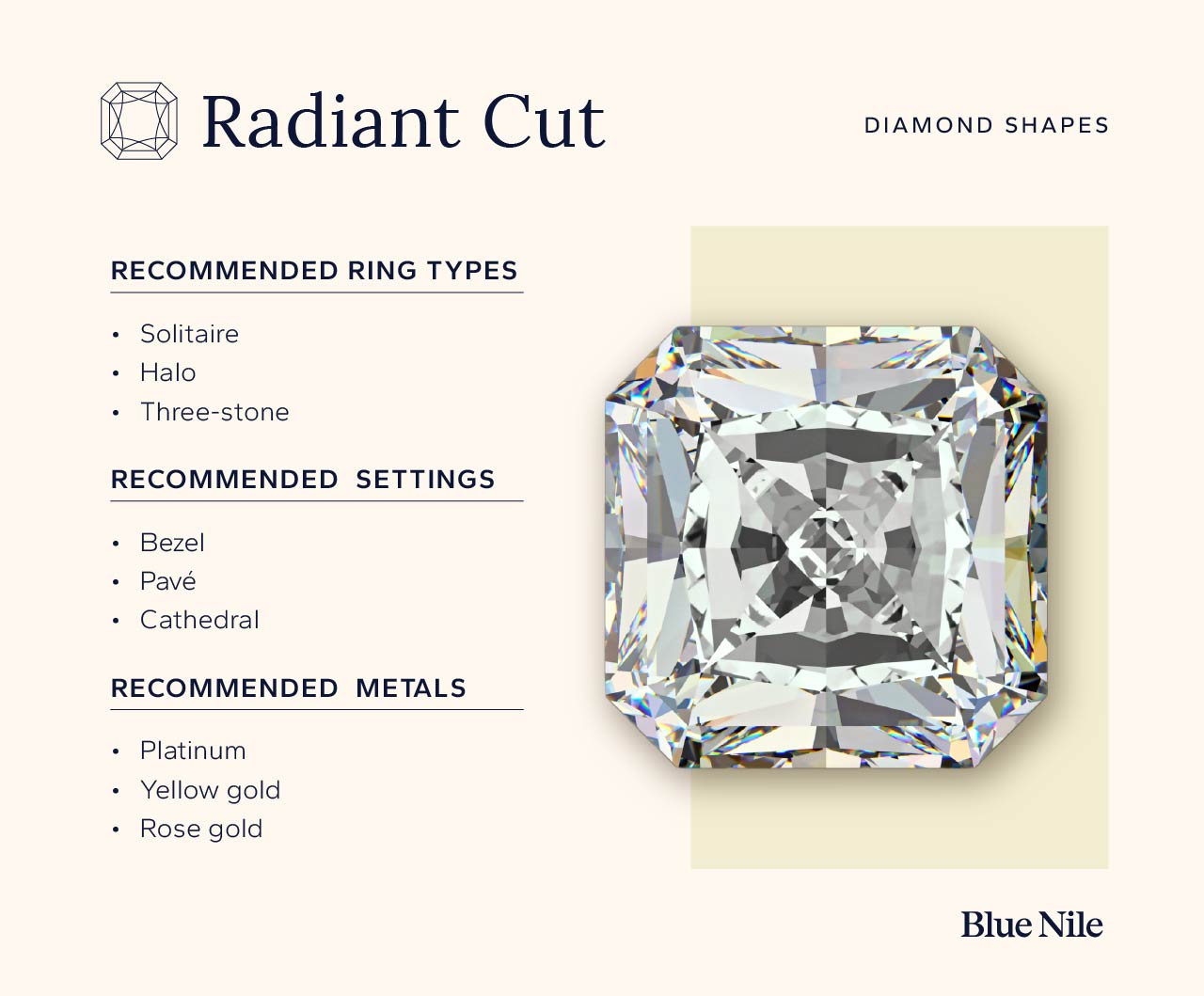
Style and Settings for Radiant Diamonds
Radiant cuts bring a modern energy to any ring. Their crisp edges and brilliance make them perfect if you love a bold, glamorous look that still works beautifully in traditional settings like solitaires or three-stone rings.
The cut’s versatile rectangular shape works in both minimalist and intricate settings, offering endless ways to personalize your ring. Because radiant diamonds reflect light from every angle, they pair well with metals that enhance their brightness, like platinum or yellow gold.
Category
Emerald cut style suggestion
Ring types
Settings
Metals
Finding the Best Quality Radiant Cut
Radiant cut diamonds are prized for their vibrance and hybrid faceting, but not all stones are created equal. To ensure your diamond shines at its best, focus on clarity, color and proportions.
- Clarity: Uneven faceting or dark spots can detract from brilliance. Look for even contrast within the facets rather than dark patches, and a clarity grade of at least VS1 for a clean appearance.
- Color: Radiants reflect light intensely, so even subtle color can be noticeable. For a near-colorless look, aim for a G or higher color grade, and choose a radiant that reflects light back through the table rather than leaking it out the sides.
- Proportions: Balanced pavilion depth and table size are critical for maximizing brilliance and fire. A balanced crown—not too flat or too steep—helps enhance both.
Avoid radiants that appear dull or overly “crushed ice” in pattern. Also be sure the setting allows for easy cleaning and inspection, since brilliance depends on keeping facets unobstructed (and knowing how to keep your diamonds clean).
Emerald Cut Diamonds
Unlike brilliant cuts that rely on sparkle, emerald cuts reveal their charm through long, linear facets that create a soft, “hall-of-mirrors” effect. Their clean lines highlight clarity and symmetry, giving them a look of understated sophistication.
Because inclusions and color are easier to spot in this shape, higher clarity and color grades tend to raise the price, while lower grades can reduce cost for buyers prioritizing size or design.
Here’s a quick breakdown of the characteristics of emerald cut diamonds:
- Facets: Emerald cuts feature 49–58 step-cut facets arranged in parallel lines, creating a smooth, reflective appearance rather than a sparkling one.
- Internal pattern: The step cut forms a hall-of-mirrors look with repeating flashes of light.
- Crown: Emerald cuts have a flatter crown than brilliant cuts, which adds to the diamond’s sleek profile but reduces fire.
- Pavilions: The pavilion’s broad, tiered facets enhance linear reflections, emphasizing symmetry and depth.
- Fire and brilliance: Emerald cuts display less fire but offer a calm glow that appeals to minimalists.
- Rarity and price: While not the rarest shape, high-quality emerald cuts require expert cutting to achieve balance and symmetry. This can influence the cost more than carat weight alone.

Style and Settings for Emerald Diamonds
Emerald cut diamonds capture vintage glamour with a clean, architectural feel. Their elongated shape flatters the hand and creates a graceful, understated look—perfect if you’re drawn to structure over sparkle.
These diamonds shine in solitaires that emphasize their geometry or in three-stone and bezel settings that highlight their symmetry. Platinum and white gold enhance their crisp lines, while yellow or rose gold lends warmth and old-world charm. Emerald cuts are a favorite choice for unique engagement rings that stand apart from the rest.
Category
Emerald cut style suggestion
Ring types
Settings
Metals
Finding the Best Quality Emerald Cut
Emerald cut diamonds are sought after for their elegant, elongated shape and distinctive hall-of-mirrors effect. To select a high-quality stone, focus on the following characteristics:
- Clarity: The emerald cut’s large, open facets make inclusions more visible. Aim for a clarity grade of VS1 or higher to ensure the diamond appears clean to the unaided eye.
- Color: The step-cut design can accentuate any color tints. For a near-colorless appearance, choose diamonds with a color grade of G or better.
- Proportions: Ideal emerald cuts typically have a length-to-width ratio between 1.40 and 1.50. This range offers a balanced shape, enhancing the diamond’s visual appeal.
Overall, prioritize balance and symmetry to highlight the diamond’s natural elegance. Choosing a well-proportioned stone ensures it will maintain a refined look for years to come.
Choosing Between Radiant and Emerald Cuts
Ultimately, your choice between a radiant vs. emerald cut diamond depends on how you want the diamond to interact with light. Radiant cuts dazzle with bold brilliance, while emerald cuts emphasize clean lines and a softer glow.
If you’re still unsure, try our diamond shape quiz to see which cut suits your taste and lifestyle best. Once you know your preference, browse our collection of loose radiant cut diamonds or loose emerald cut diamonds. Whether shopping for yourself or a loved one, these collections make it easy to find a stunning ring that reflects your vision.
Frequently Asked Questions
Emerald cut diamonds don’t sparkle as much as radiant cuts because they use a step-cut facet pattern instead of a radiant one. This creates broad flashes of light rather than the smaller, more frequent sparkles seen in round or radiant cuts, resulting in a sophisticated hall-of-mirrors effect.
Yes, emerald cuts are considered one of the most elegant and timeless diamond styles. Their clean lines and elongated shape evoke vintage glamour, making them a favorite among those who appreciate understated sophistication.
In general, emerald cut diamonds are slightly more affordable than radiant cuts of the same carat weight and quality. This is because the emerald cut retains more of the original rough diamond during shaping, which can make it more cost-efficient while still offering stunning visual appeal.
Yes, radiant cut diamonds are seeing a modern resurgence thanks to their bold sparkle and versatility in contemporary ring settings. Their hybrid design—combining the shape of an emerald cut with the brilliance of a round cut—makes them a stylish choice for anyone seeking a glamorous statement piece.
Yes, radiant cuts often appear larger than other diamond shapes of the same carat weight. Their clipped corners and brilliant facet pattern maximize light reflection and surface area, creating an illusion of greater size and sparkle on the finger.

